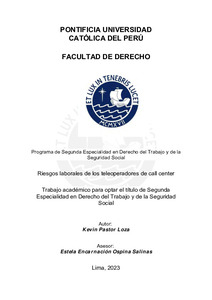| dc.contributor.advisor | Ospina Salinas, Estela Encarnación | |
| dc.contributor.author | Pastor Loza, Kevin | |
| dc.date.accessioned | 2024-04-02T15:14:56Z | |
| dc.date.available | 2024-04-02T15:14:56Z | |
| dc.date.created | 2023 | |
| dc.date.issued | 2024-04-02 | |
| dc.identifier.uri | http://hdl.handle.net/20.500.12404/27496 | |
| dc.description.abstract | El presente estudio tuvo como objetivo analizar los riesgos laborales que existen en las empresas del rubro call center. Para ello, se revisó diversa bibliografía sobre riesgos psicosociales y disergonómicos, así como antecedentes en empresas peruanas dedicadas a esta actividad.
La relevancia del estudio derivó en la necesidad de advertir que, incluso en empresas que no desarrollan actividad de alto riesgo, pueden existir riesgos con la capacidad de afectar la salud de los trabajadores. Asimismo, en la necesidad de poder conocer cuál es el nivel de cumplimiento de las normas SST y el nivel de fiscalización estatal sobre el sector.
Por tal razón, la investigación comprendió el desarrollo de dos capítulos con sus respectivas conclusiones.
El primer capítulo analizó la seguridad y salud en el trabajo en las empresas de call center, citando diversa información sobre los riesgos psicosociales y disergonómicos, cuáles son sus principales manifestaciones y consecuencias en el trabajo.
Luego de haberse revisado la bibliografía sobre la materia, se concluyó en el primer capítulo que, en los call center sí se presentan riesgos laborales, fundamentalmente de carácter psicosocial y disergonómico, los cuales afectan la salud del trabajador.
El segundo capítulo analizó la actuación inspectiva y sancionadora de SUNAFIL en el rubro call center.
Para el desarrollo de este apartado, principalmente se tuvo que recabar información pública de la entidad, como por ejemplo: a) informes anuales sobre la inspección del trabajo, b) boletines estadísticos, c) solicitudes de acceso a la información pública, d) resoluciones de procedimientos administrativos sancionadores contra empresas de call center.
Luego de haber analizado la información recabada, se concluyó en el segundo capítulo que, el índice de fiscalización en este rubro es bajo debido al número insuficiente de inspectores existentes a nivel nacional. Asimismo, se concluyó que en el sector existe un bajo nivel de cumplimiento normativo en SST, toda vez que la actuación inspectiva y sancionadora de la SUNAFIL estuvo orientada únicamente a la vigilancia de las obligaciones sociolaborales de contenido patrimonial. | es_ES |
| dc.description.abstract | The present study aimed to analyze the occupational hazards that exist in call center companies. For this purpose, diverse literature on psychosocial and disergonomic risks was reviewed, along with precedents in Peruvian companies engaged in this activity.
The relevance of the study emerged from the need to emphasize that, even in companies not involved in high-risk activities, there may be risks capable of affecting the health of workers. Additionally, there is a need to understand the level of compliance with Occupational Health and Safety (OHS) regulations and the extent of governmental oversight within the sector.
For this reason, the research involved the development of two chapters with their corresponding conclusions.
The first chapter analyzed occupational health and safety in call center companies, citing diverse information regarding psychosocial and disergonomic risks, as well as their main manifestations and consequences in the workplace.
After reviewing the literature on the subject, the first chapter concluded that call centers indeed present occupational hazards, primarily of a psychosocial and disergonomic nature, which affect the health of workers.
The second chapter examined the inspection and sanctioning actions of SUNAFIL in the call center industry.
To develop this section, it was necessary to gather public information from the entity, such as: a) annual reports on labor inspection, b) statistical bulletins, c) requests for access to public information, d) resolutions of administrative sanctioning procedures against call center companies.
After analyzing the gathered information, the second chapter concluded that the oversight rate in this sector is low due to the insufficient number of inspectors nationwide. Likewise, it was concluded that the sector exhibits a low level of compliance with occupational health and safety (OHS) regulations, given that the inspection and sanctioning actions of SUNAFIL were solely focused on monitoring socio-labor obligations with a financial nature. | es_ES |
| dc.description.uri | Trabajo académico | es_ES |
| dc.language.iso | spa | es_ES |
| dc.publisher | Pontificia Universidad Católica del Perú | es_ES |
| dc.rights | info:eu-repo/semantics/closedAccess | es_ES |
| dc.subject | Centros de atención telefónica--Perú | es_ES |
| dc.subject | Condiciones de trabajo--Perú | es_ES |
| dc.subject | Trabajadores--Derechos--Perú | es_ES |
| dc.title | Riesgos laborales de los teleoperadores de call center | es_ES |
| dc.type | info:eu-repo/semantics/bachelorThesis | es_ES |
| thesis.degree.name | Segunda Especialidad en Derecho del Trabajo y de la Seguridad Social | es_ES |
| thesis.degree.level | Título Profesional | es_ES |
| thesis.degree.grantor | Pontificia Universidad Católica del Perú. Facultad de Derecho | es_ES |
| thesis.degree.discipline | Derecho del Trabajo y de la Seguridad Social | es_ES |
| renati.advisor.dni | 06722520 | |
| renati.advisor.orcid | https://orcid.org/0000-0002-5361-9777 | es_ES |
| renati.author.dni | 48488280 | |
| renati.discipline | 422059 | es_ES |
| renati.level | https://purl.org/pe-repo/renati/level#tituloSegundaEspecialidad | es_ES |
| renati.type | https://purl.org/pe-repo/renati/type#trabajoAcademico | es_ES |
| dc.publisher.country | PE | es_ES |
| dc.subject.ocde | https://purl.org/pe-repo/ocde/ford#5.05.01 | es_ES |






